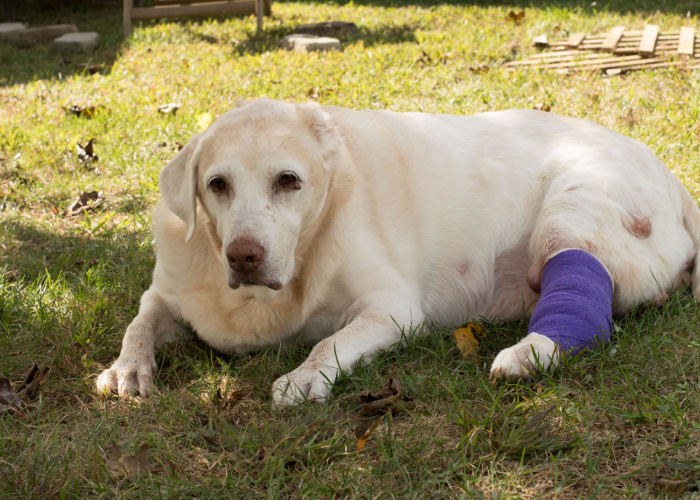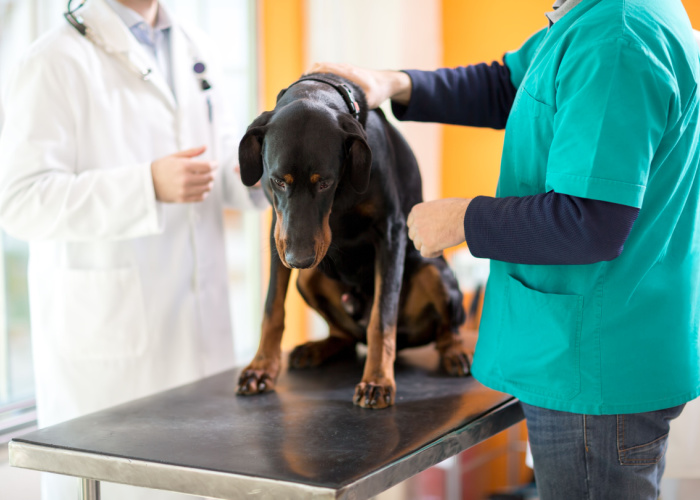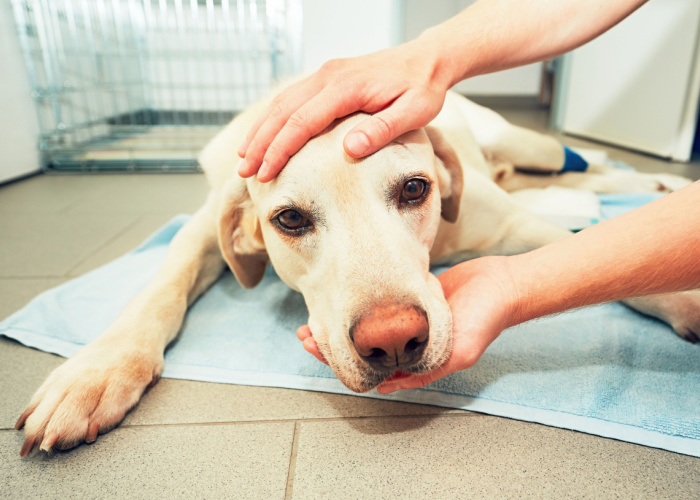Table of Contents
- What is Myeloma (Bone Marrow Cancer) In Dogs?
- How Does Myeloma (bone marrow cancer) in Dogs Develop?
- Main Causes of Myeloma (Bone Marrow Cancer) In Dogs
- Symptoms of Myeloma (Bone Marrow Cancer) In Dogs
- How to Diagnose Multiple Myeloma in Dogs
- How do you treat myeloma in dogs?
- Can You Prevent Myeloma (Bone Marrow Cancer) In Dogs?
- What to Feed Dogs During Cancer Treatment
- Other Foods that Dogs with Cancer Can Eat
- What to Avoid Feeding Dogs with Cancer
- Myeloma (Bone Marrow Cancer) In Dogs: 6 Supplies to Support Your Pup’s Journey
- Myeloma (Bone Marrow Cancer) In Dogs: FAQs
- Myeloma (Bone Marrow Cancer) In Dogs: Before You Go…
One thing’s for sure: Cancer sucks.
Not only does it deprive our loved ones of a chance to live healthily…
Unfortunately, so are our pets.
And the worst thing about myeloma (bone marrow cancer) in dogs is that it’s not curable.
However, this so-called plasma cell tumor in dogs won’t take an easy toll on your pups.
According to Dr. Nancy Kay, DVM, DACVIM:
“…this relatively uncommon canine disease can be successfully treated.”
And especially with the right and early treatment (more on that in a bit), multiple myeloma in dogs can’t stop their fighting spirit to live.
“…92% experienced remission (evidence of cancer partially to completely resolving).”
Yes, that’s according to a study conducted on 60 dogs with bone marrow cancer.
Today, I compiled a jam-packed blog for concerned pet owners like you.
So, stay for a while as we break down some of the most vital information you need to know, like:
- Symptoms to look out for in dogs with myeloma
- Phases of bone marrow cancer development in dogs
- Treatments and vet-prescribed diet for dogs with cancer
- And so much more!

What is Myeloma (Bone Marrow Cancer) In Dogs?
Myeloma in dogs is a rare medical condition where the uncontrolled growth of cancerous plasma cells (tumors) affects their bone marrow.
What are plasma cells?
Plasma cells are responsible for creating antibodies to help fight infections and diseases.
This cell type focuses on maintaining your dog’s immune system.
Unfortunately, plasma cell tumors in dogs can develop into 2 types:
- Benign (non-cancerous) – commonly grows in your dog’s mouth and face
- Malignant (cancerous) – affect one or multiple organs in your dog’s body (e.g., bone, bone marrow, or the gastrointestinal tract)
Plasma Cell Tumors in Dogs
Cancerous plasma cell tumors like multiple myeloma in dogs are extremely rare that affect:
“…less than 1% of all malignant tumors in cats and dogs.” — VCA Animal Hospitals
Commonly referred to as myeloma or plasma cell myeloma, this rare disease affects “8% of dogs with [bone] tumors.”
How Does Myeloma (bone marrow cancer) in Dogs Develop?
Multiple myeloma in dogs develops in their bone marrow. For your reference, here’s a quick summary below:
Phase 1: Some lymphocytes become plasma cells
Lymphocytes are a normal white blood type that can be found in your dog’s bone marrow, which can evolve into plasma cells.
Trivia: Multiple myeloma cells come from lymphocytes.
Phase 2: Too much production of plasma cells
The uncontrolled production of plasma cells in your dog’s bone marrow often results in cancerous development.
This overcrowds your dog’s bone marrow, making it difficult to produce its vital components, such as the following:
- Platelets
- Red blood cells (RBC)
- White blood cells (WBC)
Phase 3: Spreading of cancerous plasma cells in your dog’s body
Cancerous plasma cells infect other parts of your dog’s body, especially in the bones where the infection has already occurred.
Phase 4: Thickening of the blood
From the normal watery consistency to syrup-like, your dog’s blood is hugely affected by the overproduction of plasma cells in its bone.
This phenomenon is due to the immunoglobulin that plasma cells produce.
What is immunoglobulin?
Immunoglobulin is a protein substance that helps fight infections in your dog’s body.
However, too much of this protein substance in your dog’s bloodstream causes damage to small blood vessels and tissues.
Referred to as hyperviscosity syndrome, this is a life-threatening condition that can severely affect your pup’s brain.
And in cases with myeloma in dogs, this condition is likely to occur since the overproduction of plasma cells means too much presence of immunoglobulin.

Main Causes of Myeloma (Bone Marrow Cancer) In Dogs
According to a study, myeloma (bone marrow cancer) in dogs can occur from unknown causes.
Unlike in humans, plasma cell myeloma in dogs knows no specific canine breed or sex.
However, multiple myeloma in dogs often occurs when they reach middle or old age.
Symptoms of Myeloma (Bone Marrow Cancer) In Dogs
Signs of multiple myeloma in dogs can vary depending on specific conditions such as:
- Thickening of the blood
- Spreading of cancer cells
- Abnormal or very few levels of RBC, WBC, and platelets
However, here are some of the most common symptoms of myeloma (bone marrow cancer) in dogs:
- Seizures
- Bone pain
- Weakness
- Lameness
- Loss of vision
- Loss of appetite
- Increased thirst
- Excessive urination
In some cases, plasma cell myeloma in dogs can also result in hypercalcemia or too much calcium in the bloodstream.
Over time, this condition can result in kidney failure, too.
How to Diagnose Multiple Myeloma in Dogs
To diagnose myeloma in dogs, your vet will perform the following procedures:
- X-ray – to assess bone characteristics and structure
- Bone marrow analysis – to determine the amount of plasma cells
- Urinalysis – to check if your dog’s urine contains Bence-Jones proteins (a type of immunoglobulin protein)
Apart from the above physical exams, your vet may also perform the following tests to assess your dog’s condition properly:
- Blood sampling
- Abdominal ultrasound
- Bone marrow collection
How do you treat myeloma in dogs?
Treatment of myeloma in dogs can vary depending on the resulting medical conditions.
But some of the most common treatments include the following:
- Antibiotics
- Chemotherapy
- Radiation therapy
- Biphosphonates (bone pain reliever)
Most importantly, early treatments are the best way to help your dog cope with bone marrow cancer.
Plus, a vet that specializes in oncology or internal medicine is a huge help, too.
Can You Prevent Myeloma (Bone Marrow Cancer) In Dogs?
Unfortunately, since there are no known causes of myeloma in dogs, there’s also no preventive measure against it. It’s best to consult your vet for proper assessment.

What to Feed Dogs During Cancer Treatment
Dogs undergoing cancer treatments must have well-balanced nutrition for optimal health support.
Note: We recommend consulting your vet for more accurate and personalized advice on your dog’s diet while getting cancer treatments.
Fat
A diet that’s high in fat can benefit dogs with cancer, especially since cancer cells have difficulty using fat as an energy source.
Additionally, dogs with cancer need a diet that’s rich in omega-3 fatty acids, which is known to be an anti-tumor.
“…canine cancer patients eat a ration with 25-40% DM [dry matter] fat and 5% DM or greater of dietary omega-3 fatty acids.” — VCA Animal Hospitals
Protein
Dogs with cancer need sufficient protein intake due to their imbalance in protein metabolism.
And especially since protein is vital in maintaining a lean body mass, your dog’s diet should contain higher protein levels than normal pups.
“The current recommendation for canine cancer patients is a protein level of 30-40% DM.” — VCA Animal Hospitals
Caution: If your dogs have liver and kidney problems, be sure to consult your vet first before giving it a protein-rich diet.
RELATED: Renal Diet for Dogs: A Guide on Feeding
Other Foods that Dogs with Cancer Can Eat
Especially for canine cancer patients without other health concerns, you can feed them with the following:
Easy-to-Digest, Fatty, and High-Quality Protein Foods
- Fish
- Pork
- Eggs
- Turkey
- Chicken
Store-Bought Dog Food
- Formulated for canine cancer patients
- Contains fat and highly digestible protein
- Helps support the canine gut environment
- With essential omega-3 fatty acids for immune system support
- Contains a unique blend of prebiotics for consistent stool quality
Homemade Meals
- Fish
- Pork
- Poultry
- Broccoli
- Strawberries
- Organ meat like liver
- Cauliflower and turnips (with cancer-fighting properties)
Supplements for Dogs with Cancer
- Iron
- Probiotics
- Amino acids
- EPA and DHA
- Vitamin B complex
What to Avoid Feeding Dogs with Cancer
Not only humans but dogs suffering from cancer can experience adverse effects while undergoing treatments.
Not to mention a lack of saliva or the growth of mouth ulcers.
In some cases, dogs with cancer also experience the following after-effects:
- Nausea
- Vomiting
- Diarrhea
- Loss of appetite
And since we already talked about the canine diet that’s ideal for cancer patients, here are some nutrient profiles that you SHOULD NOT feed them:
Carbohydrates
Dr. Carol Osborne, DVM, of Chagrin Falls Veterinary Center & Pet Clinic, says that cancer mainly benefits from oxygen and carbohydrates.
“…while we can’t adjust the oxygen, we can adjust the carbs.”
That being said, feeding inappropriate amounts of carbs to your dogs can make the cancer cells healthy while weakening your pup.
According to VCA Animal Hospitals, “…dogs with cancer should eat a nutrient profile with no more than 25% carbohydrate on a dry matter (DM) basis.”
Note: There’s no universal diet that suits all dogs with cancer.
However, dogs with cancer often suffer an impaired carbohydrate metabolism.
Some dogs may not be suitable for grain-rich foods; some may need oats and other whole grains.
But according to Dr. Adam Christman of dvm360®, it’s best for pet owners to be aware that:
“Cancer cells metabolize glucose from carbohydrates through a process called anaerobic glycolysis, which forms lactate as a byproduct.”
What happens, then?
Your dog’s body must use energy to convert lactate into a usable form.
As a result, the tumor cell gets energized while your pup ends up energy-deficient.
Again: Your vet must be the first person you seek advice from regarding this matter.
Myeloma (Bone Marrow Cancer) In Dogs: 6 Supplies to Support Your Pup’s Journey
1. Pet Ramp
Since your dog’s condition can limit its capabilities, it’s better to offer support whenever you can.
And especially for dogs with bone marrow cancer, you need to put pet ramps in the following areas/scenarios:
2. Harness
Especially for dogs with trouble moving their legs, a good-quality lift or sling harness can help.
Apart from supporting their body while walking, harnesses also lessen the pressure on your pup’s affected area.
Be sure to adjust it comfortably on your dog’s body — not to lose and not too tight.
3. Dog Diaper
Dogs with myeloma often suffer from urine and fecal incontinence or the inability to control bowel movement.
In this case, you might want to invest in some good-quality dog diapers.
However, be sure to replace used diapers immediately and clean your dog’s bum to prevent skin infections like moist dermatitis.
4. Wheelchair
Apart from harnesses, you can also try putting your pups in a wheelchair to help support their movements.
However, this method should be done with expert advice from your vet, rehab specialist, or physical therapist.
5. Rugs
One simple household stuff that can help prevent accidents for your dogs is the use of the mighty rug.
Although strategically placing a rug at home isn’t that complicated, you need to put rugs on slippery surfaces, such as in the bathroom or kitchen.
Of course, you’ll also need to avoid placing rugs on staircases or elevated platforms to prevent your pups from slipping when they step on them.
6. Booties
For better traction while walking or moving, you can also try putting on some cool booties for your dogs.
This cute dog footwear will help them take steps safely.
Also, dog booties can help keep your pup’s paws from dirt, sharp objects, or concrete chemicals on the surface.
Myeloma (Bone Marrow Cancer) In Dogs: FAQs
How long do dogs live with myeloma cancer?
With proper and early treatment, dogs with multiple myeloma or bone marrow cancer can enjoy an additional life expectancy of up to 2.5 years.
But on the contrary, dogs with myeloma can die within 6 weeks if left untreated.
Does bone marrow cancer spread fast in dogs?
Myeloma (bone marrow cancer) in dogs are cancerous and can spread rapidly in their body, especially in the absence of an early diagnosis.
So, it’s important to consult your vet whenever you notice some symptoms of plasma cell myeloma in your dogs.
Can dogs survive with myeloma?
Dogs with myeloma have an average survival time of about 540 days.
Although considered to be incurable, myeloma in dogs is a treatable form of cancer.
And fortunately, dogs with myeloma respond better to cancer treatments like chemotherapy.

Myeloma (Bone Marrow Cancer) In Dogs: Before You Go…
Talking about cancer is almost a sensitive topic for some people.
That’s because of the unexplainable pain that this disease has caused them.
Despite the fact that myeloma (bone marrow cancer) in dogs is a rare occurrence, it’s still a life-threatening condition.
Also known as multiple myeloma or plasma cell tumor in dogs, this dangerous health condition scares a lot of pet owners.
Fortunately, this bone marrow cancer in dogs is treatable.
Especially since dogs also positively respond to cancer treatments, making the most of your pup’s life is a chance you don’t wanna miss.
Don’t forget, however, that an early diagnosis is the best thing you can do for your beloved pooch.
For more related blogs, you can check our top recommendations below!













